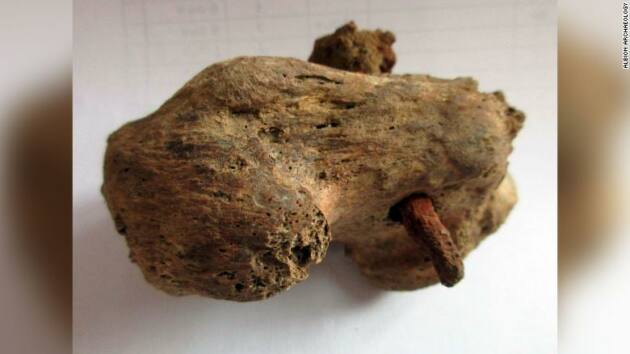Archaeologists have found the skeleton of a man that appears to have been crucified by the Romans in the United Kingdom.
Corinne Duhig, a human bone specialist at Cambridge University’s Wolfson College, said the find is rare because of its good preservation. “This shows that the inhabitants of even this small settlement at the edge of empire could not avoid Rome’s most barbaric punishment,” she said.
The skeleton, of a man between 25 and 35, actually was uncovered 2017 without the nail being noticed, because it was surrounded by mud. The nail was revealed in the heel after the bones were removed and cleaned in the lab.
The skeleton of the crucified man showed signs of injuries, leading scientists to believe he suffered before his death. His legs revealed signs of infection, possibly caused by binding or shackles.
Speaking on behalf of Cambridgeshire County Council’s historic environment team, archaeologist Kasia Gdaniec said, “These cemeteries and the settlement that developed along the Roman road at Fenstanton are breaking new ground in archaeological research. Burial practices are many and varied in the Roman period and evidence of ante- or post-mortem mutilation is occasionally seen, but never crucifixion.
There has only been one other example of a nail surviving through the bone, experts from Albion Archaeology said. This was in Giv’at ha-Mivtar in north Jerusalem during building work in 1968. Skeletons with a similar hole have been discovered in Gavello in Italy and at Mendes in Egypt, but without a nail in place and doubt as to how the holes were formed.
Nails were typically removed from the deceased and then reused but in this case, the nail had bent upon insertion, preventing its removal at the time the man died.
For decades, prior to 1968, some had doubted the Bible’s historical account of crucifixion. Over the last 50 years, they have often grudgingly acknowledged the Bible’s account is accurate as evidence was revealed.
“We look forward to finding out more when the results are published. Hopefully, there will be a museum exhibit to showcase the remains soon and we are working to arrange this.”
–Alan Goforth | Metro Voice
